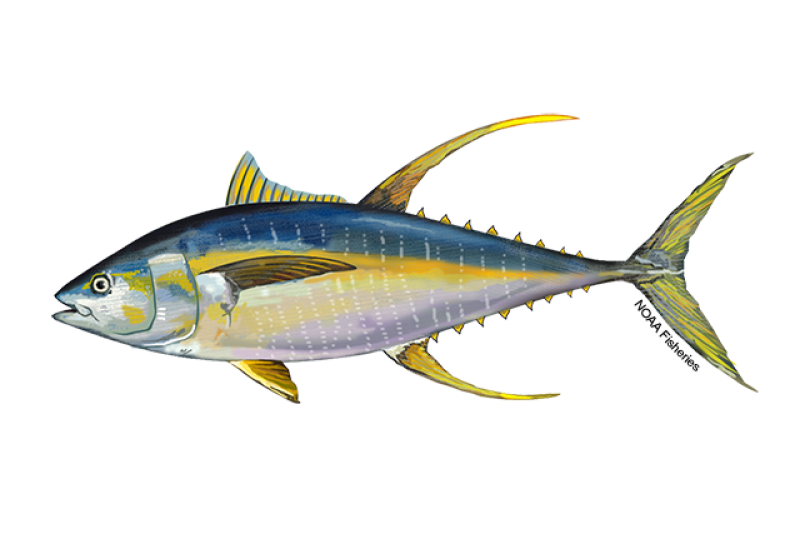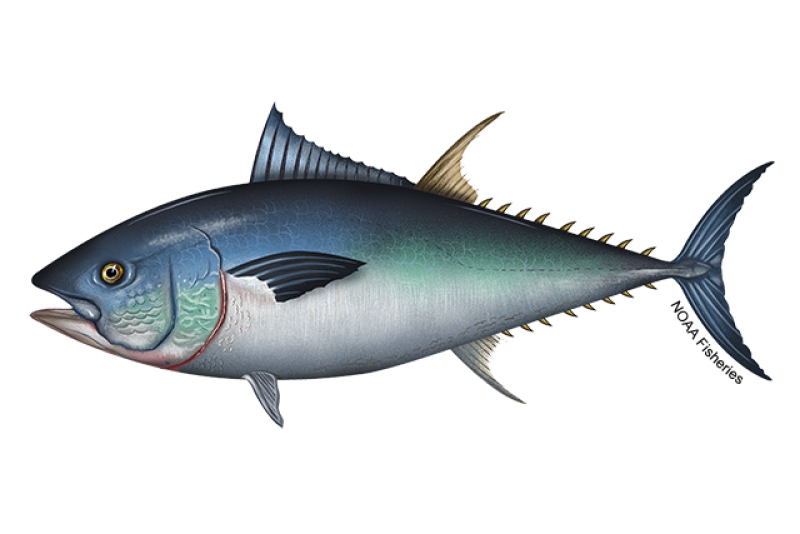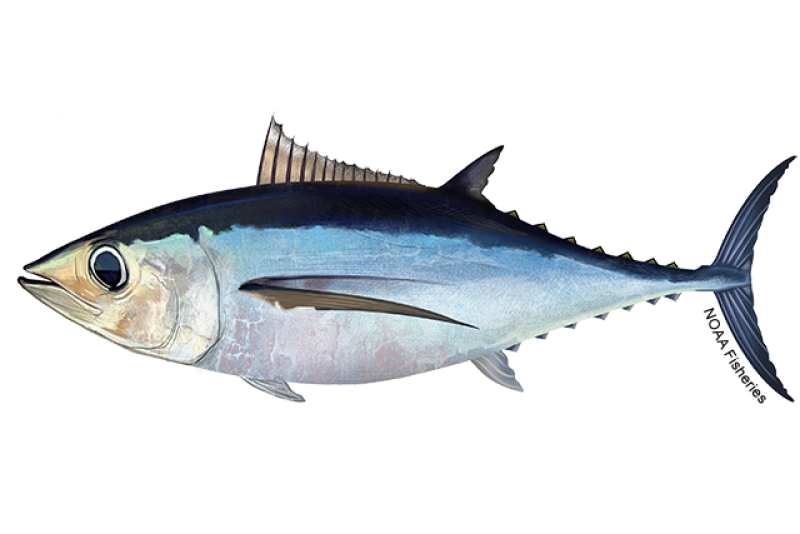About the Species
U.S. wild-caught Atlantic bigeye tuna is a smart seafood choice because it is sustainably managed and responsibly harvested under U.S. regulations.

Population
The stock is overfished, but the fishing rate established under a domestic conservation and management plan promotes population growth.

Fishing Rate
Not subject to overfishing.

Habitat Impact
Fishing gear used to catch bigeye tuna rarely contacts the seafloor so habitat impacts are minimal.

Bycatch
Regulations are in place to minimize bycatch.
Population Status
- According to the 2021 stock assessment, Atlantic bigeye tuna is overfished, but not subject to overfishing. Summary stock assessment information can be found on Stock SMART.
- The International Commission for the Conservation of Atlantic Tunas (ICCAT) assesses the abundance of Atlantic bigeye tuna and evaluates the sustainability of current and proposed harvest practices. They use the scientific information from these assessments to make management recommendations.
Appearance
- Bigeye tuna are dark metallic blue on the back and upper sides and white on the lower sides and belly.
- The first fin on their back is deep yellow, the second dorsal and anal fins are pale yellow, and the finlets are bright yellow with black edges.
- Bigeye and yellowfin tuna look fairly similar. In fact, it’s hard to distinguish the two species without experience.
- Among other characteristics, the bigeye’s eyes are larger than the yellowfin’s and their finlets have black edges.
Biology
- Bigeye tuna grow fast and can reach about 5.5 feet in length.
- They can live up to 9 years and are able to reproduce when they are 3.5 years old.
- Bigeye tuna spawn throughout the year but most often in the summer.
- They usually spawn two or more times a year.
- Females release between 3 million and 6 million eggs each time they spawn.
- Bigeye tuna feed near the top of the food chain, preying on fish, crustaceans, and squid.
- They are prey for many top predators, including sharks, billfish, larger tunas, and toothed whales.
Where They Live
Range
- Bigeye tuna live in the tropical and warm temperate waters of the Atlantic, Pacific, and Indian Oceans.
- In the western Atlantic, they can be found from Southern Nova Scotia to Brazil.
Habitat
- Bigeye tuna are a highly migratory species, swimming long distances throughout the ocean.
- They often swim in schools and live at or near the surface but dive into deeper waters (to about 800 feet, deeper than other tropical tunas) during the day.
- Larvae are found in tropical waters, and as juvenile fish grow larger they tend to move into temperate waters.
- As juveniles they often school with yellowfin and skipjack tunas at the surface, especially in warm waters.
Fishery Management
- NOAA Fisheries and the Atlantic Highly Migratory Species Division manage the Atlantic bigeye tuna fishery in the United States.
- Managed under the 2006 Consolidated Atlantic Highly Migratory Species Fishery Management Plan:
- Commercial fishermen must have a permit to harvest bigeye tuna
- Gear restrictions
- Time/area closures
- Minimum size limit
- Federal management for Atlantic tunas applies to state waters as well, except in Maine, Connecticut, and Mississippi. NOAA Fisheries periodically reviews these states’ regulations to make sure they’re consistent with federal regulations.
- Highly migratory species, such as bigeye tuna, have complicated management that requires international cooperation.
- The United States participates in regional fisheries management organizations, such as the International Commission for the Conservation of Atlantic Tunas (ICCAT), to enhance tuna management worldwide and promote the rigorous stewardship standards followed by our own U.S. fishermen.
- NOAA Fisheries sets regulations for the U.S. western Atlantic bigeye tuna fishery based on our science as well as conservation and management measures adopted by ICCAT. ICCAT conservation and management recommendations include:
- An annual total allowable catch of 61,500 metric tons in 2021 allocated among major harvesters, sharing arrangements for member countries, minimum size limits, effort controls, time/area closures, trade tracking requirements, compliance measures, and monitoring and inspection programs.
- ICCAT remains concerned about unreported catches and is actively working to improve statistics by working with tuna canneries in West Africa.
- Since 2011, ICCAT has also instituted numerous requirements related to catch reporting and measures to manage the use of fishy aggregating devices.
- The United States has strongly advocated for management measures at ICCAT to end overfishing and rebuild the stock. NOAA Fisheries will continue to work with ICCAT to develop effective measures to end overfishing and to implement an international rebuilding program.
- In 2000, the United States established the Dolphin-Safe Tuna Tracking and Verification Program to monitor the domestic production and importation of all frozen and processed tuna products nationwide and to authenticate any associated dolphin-safe claim.
Harvest
- Commercial fishery:
- U.S. harvest of Atlantic bigeye tuna is usually only a small fraction (1 percent or less) of the global Atlantic bigeye harvest.
- Gear types, habitat impacts, and bycatch:
- U.S. commercial fishermen mainly harvest bigeye tuna using pelagic longlines. They sometimes use rod-and-reel gear.
- Fishing gear used to catch bigeye tuna rarely contacts the seafloor so habitat impacts are minimal.
- Commercial fishing gear can catch protected species such as marine mammals and sea turtles.
- NOAA Fisheries has taken the following additional measures to reduce bycatch, bycatch mortality, and sustainably manage the pelagic longline fishery. Fishermen are:
- Required to use large circle hooks and certain types of bait that limit gear interactions with sea turtles. Circle hooks are specifically designed to minimize the damage caused by hooking, giving animals that are captured and released a better chance at survival.
- Trained to use special techniques to safely dehook and release any incidentally caught turtles.
- Required to stop fishing and move 1 nautical mile if they encounter a protected species.
- Required to protect pilot whales and Risso's dolphins when fishing in the Mid-Atlantic Bight by limiting the length of their lines to 20 nautical miles and posting marine mammal handling/release guidelines on their vessels. In addition, if fishing in the Cape Hatteras Special Research Area, pelagic longliners must contact NOAA Fisheries at least 48 hours prior to a trip and carry observers if requested.
- Required to use weak hooks in the Gulf of America (formerly Gulf of Mexico) to reduce incidental catch of bluefin tuna and prohibited from using live bait to reduce bycatch of billfish.
- Restricted from certain areas of the Gulf of America to reduce bycatch of multiple species.
- Required to carry vessel monitoring systems onboard their boats to ensure compliance with these closures.
- Required to carry at-sea fisheries observers upon request. NOAA Fisheries reviews observer data to monitor protected species interactions and takes appropriate action as necessary.
- Required to install electronic monitoring (cameras) and submit camera hard drives to NOAA Fisheries to monitor bluefin tuna catch and discards.
- Recreational fishery:
- Recreational fishermen must have a permit to fish for bigeye tuna.
- Minimum size limit
- Recreational fishing for highly migratory species such as bigeye tuna provides significant economic benefits to coastal communities through individual angler expenditures, recreational charters, tournaments, and the shoreside businesses that support those activities.
Scientific Classification
- Bigeye tuna live in the tropical and warm temperate waters of the Atlantic, Pacific, and Indian Oceans.
- In the western Atlantic, they can be found from Southern Nova Scotia to Brazil.
- Bigeye tuna are a highly migratory species, swimming long distances throughout the ocean.
- They often swim in schools and live at or near the surface but dive into deeper waters (to about 800 feet, deeper than other tropical tunas) during the day.
- Larvae are found in tropical waters, and as juvenile fish grow larger they tend to move into temperate waters.
- As juveniles they often school with yellowfin and skipjack tunas at the surface, especially in warm waters.
Fishery Management
- NOAA Fisheries and the Atlantic Highly Migratory Species Division manage the Atlantic bigeye tuna fishery in the United States.
- Managed under the 2006 Consolidated Atlantic Highly Migratory Species Fishery Management Plan:
- Commercial fishermen must have a permit to harvest bigeye tuna
- Gear restrictions
- Time/area closures
- Minimum size limit
- Federal management for Atlantic tunas applies to state waters as well, except in Maine, Connecticut, and Mississippi. NOAA Fisheries periodically reviews these states’ regulations to make sure they’re consistent with federal regulations.
- Highly migratory species, such as bigeye tuna, have complicated management that requires international cooperation.
- The United States participates in regional fisheries management organizations, such as the International Commission for the Conservation of Atlantic Tunas (ICCAT), to enhance tuna management worldwide and promote the rigorous stewardship standards followed by our own U.S. fishermen.
- NOAA Fisheries sets regulations for the U.S. western Atlantic bigeye tuna fishery based on our science as well as conservation and management measures adopted by ICCAT. ICCAT conservation and management recommendations include:
- An annual total allowable catch of 61,500 metric tons in 2021 allocated among major harvesters, sharing arrangements for member countries, minimum size limits, effort controls, time/area closures, trade tracking requirements, compliance measures, and monitoring and inspection programs.
- ICCAT remains concerned about unreported catches and is actively working to improve statistics by working with tuna canneries in West Africa.
- Since 2011, ICCAT has also instituted numerous requirements related to catch reporting and measures to manage the use of fishy aggregating devices.
- The United States has strongly advocated for management measures at ICCAT to end overfishing and rebuild the stock. NOAA Fisheries will continue to work with ICCAT to develop effective measures to end overfishing and to implement an international rebuilding program.
- In 2000, the United States established the Dolphin-Safe Tuna Tracking and Verification Program to monitor the domestic production and importation of all frozen and processed tuna products nationwide and to authenticate any associated dolphin-safe claim.
Harvest
- Commercial fishery:
- U.S. harvest of Atlantic bigeye tuna is usually only a small fraction (1 percent or less) of the global Atlantic bigeye harvest.
- Gear types, habitat impacts, and bycatch:
- U.S. commercial fishermen mainly harvest bigeye tuna using pelagic longlines. They sometimes use rod-and-reel gear.
- Fishing gear used to catch bigeye tuna rarely contacts the seafloor so habitat impacts are minimal.
- Commercial fishing gear can catch protected species such as marine mammals and sea turtles.
- NOAA Fisheries has taken the following additional measures to reduce bycatch, bycatch mortality, and sustainably manage the pelagic longline fishery. Fishermen are:
- Required to use large circle hooks and certain types of bait that limit gear interactions with sea turtles. Circle hooks are specifically designed to minimize the damage caused by hooking, giving animals that are captured and released a better chance at survival.
- Trained to use special techniques to safely dehook and release any incidentally caught turtles.
- Required to stop fishing and move 1 nautical mile if they encounter a protected species.
- Required to protect pilot whales and Risso's dolphins when fishing in the Mid-Atlantic Bight by limiting the length of their lines to 20 nautical miles and posting marine mammal handling/release guidelines on their vessels. In addition, if fishing in the Cape Hatteras Special Research Area, pelagic longliners must contact NOAA Fisheries at least 48 hours prior to a trip and carry observers if requested.
- Required to use weak hooks in the Gulf of America (formerly Gulf of Mexico) to reduce incidental catch of bluefin tuna and prohibited from using live bait to reduce bycatch of billfish.
- Restricted from certain areas of the Gulf of America to reduce bycatch of multiple species.
- Required to carry vessel monitoring systems onboard their boats to ensure compliance with these closures.
- Required to carry at-sea fisheries observers upon request. NOAA Fisheries reviews observer data to monitor protected species interactions and takes appropriate action as necessary.
- Required to install electronic monitoring (cameras) and submit camera hard drives to NOAA Fisheries to monitor bluefin tuna catch and discards.
- Recreational fishery:
- Recreational fishermen must have a permit to fish for bigeye tuna.
- Minimum size limit
- Recreational fishing for highly migratory species such as bigeye tuna provides significant economic benefits to coastal communities through individual angler expenditures, recreational charters, tournaments, and the shoreside businesses that support those activities.
Scientific Classification
| Kingdom | Animalia | Phylum | Chordata | Class | Actinopterygii | Order | Scombriformes | Family | Scombridae | Genus | Thunnus | Species | obesus |
|---|
Last updated by NOAA Fisheries on 04/03/2025
Featured News
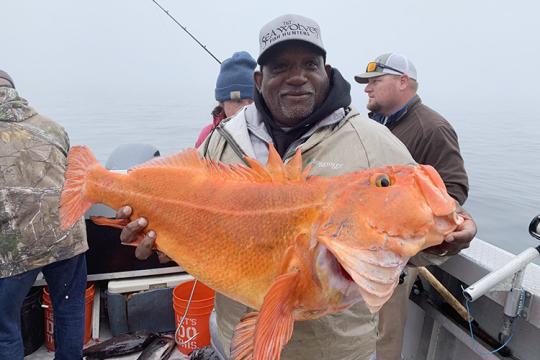
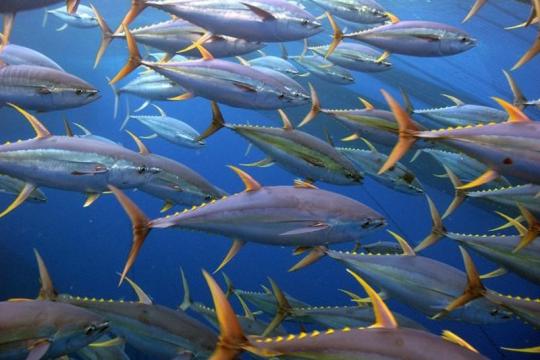 Tuna. Credit: NOAA Fisheries
Tuna. Credit: NOAA Fisheries
 Juvenile coho salmon. Credit: iStock
Juvenile coho salmon. Credit: iStock
NOAA Fisheries Releases 2023 Status of Stocks
 School of yellowfin tuna. Credit: Jeff Muir
School of yellowfin tuna. Credit: Jeff Muir
Seafood Facts

Is Atlantic Bigeye Tuna Sustainable?
U.S. wild-caught Atlantic bigeye tuna—while only a small percent (about 1 percent) of the total Atlantic-wide harvest—is a smart seafood choice because it is sustainably managed and responsibly harvested under U.S. regulations.
Availability
Year-round.
Source
U.S. wild-caught from Massachusetts to Florida.
Taste
Bigeye tuna has a mild, meaty flavor, with a higher fat content than yellowfintuna. Sashimi lovers prefer it.
Texture
Firm and moist with large flakes.
Color
Bigeye tuna meat has a reddish-pink color.
Health Benefits
Bigeye tuna is low in saturated fat and sodium and is rich in niacin, vitamins B6 and B12, selenium, and phosphorous.
Nutrition Facts
Servings: 1; Serving Weight: 113 g; Calories: 130; Protein: 27 g; Total Fat: 2 g; Total Saturated Fatty Acids: 0.5 g; Carbohydrate: 0 g; Total Sugars: 0 g; Total Dietary Fiber: 0 g; Cholesterol: 45 mg; Selenium: 160% daily value; Sodium: 70 mgBigeye (Ahi) Tuna Recipes
Bigeye (ahi) tuna is prized for its sashimi and makes a delicious seared tuna steak. If you need cooking inspiration, browse these recipes for seared tuna, tuna ceviche, and more!

Last updated by NOAA Fisheries on 04/03/2025
Seafood News
 Celebrate Culinary Arts Month with a sustainable seafood recipe for every month of the year.
Celebrate Culinary Arts Month with a sustainable seafood recipe for every month of the year.
What Your Birth Month Says About Your Next Seafood Recipe
 Fresh-caught taʻape on ice. Credit: Conservation International Hawaiʻi.
Fresh-caught taʻape on ice. Credit: Conservation International Hawaiʻi.
Reducing Waste and Feeding Communities in Hawaiʻi with a Whole Fish Approach
 Chef Tyler Hadfield’s Curried Skate Wings with Tomato-Masala Chutney
Chef Tyler Hadfield’s Curried Skate Wings with Tomato-Masala Chutney
Ring In the New Year With These Crowd-Favorite Seafood Recipes
 NOAA Fisheries, in collaboration with Blue Ocean Mariculture, is conducting a multi-year pilot study to evaluate observational methods and tools for studying Hawaiian monk seal behavior. Courtesy of Blue Ocean Mariculture
NOAA Fisheries, in collaboration with Blue Ocean Mariculture, is conducting a multi-year pilot study to evaluate observational methods and tools for studying Hawaiian monk seal behavior. Courtesy of Blue Ocean Mariculture
AI Meets Aquaculture to Study Hawaiian Monk Seal Interactions With Net Pens
Research
Top Fish Taggers for the Cooperative Tagging Center
NOAA Fisheries greatly appreciates the many tagging teams and anglers who tag and release fish to support our science.
Outreach & Education
A Guide to Tunas of the Western Atlantic Ocean
Waterproof booklet to help commercial, for-hire, and recreational fishermen and fish dealers/buyers…
Caribbean Saltwater Recreational Fisheries Snapshot
Puerto Rico and the U.S. Virgin Islands saltwater recreational fisheries fact sheet highlighting…
Last updated by NOAA Fisheries on 04/03/2025


